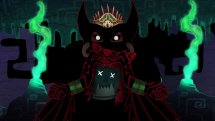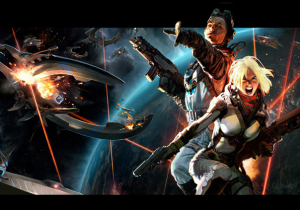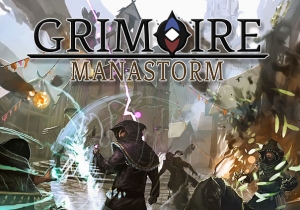Grimoire: Manastorm – First Look
Arena shooters have never really left the public eye, but there certainly has been a lot of buzz around them with games like OverWatch, Paladins, and Quake Champions trying to capture a share of the e-Sports spotlight. Omniconnection is trying to put a different spin on it with Grimoire: Manastorm, an arena shooter with a focus on fast-paced magical combat. So, were they able to work their magic, or does Grimoire’s spell fizzle out?
I want to start off by saying that Grimoire has left me the most conflicted I’ve felt about a game in a long time. It’s worth noting that the game is in alpha right now, and has a rather small team working on it. Hopefully, this means that the game will grow and change as time goes on.
On one hand, and arguably the most important hand, the gameplay is fun. Grimoire isn’t super complicated; if you’ve played any kind of arena shooter in the last 6 years you know the deal. You can pick from one of six characters, each with their own loadout of magic spells. They can unlock more spells to customize their loadout to fit your preferred playstyle, and that’s a huge drawing point. You can even change your standard utility spells (think Summoner spells from League of Legends) to even further build your character a certain way.
The primary game modes are death-match and conquest. Death-match has you capturing a series of points on the map and holding them. It’s the same capture mode you’ve seen in any other shooter, just like death match is the same death match you’ve seen over and over. It’s not a bad thing, but it’s nothing new.
Each of the characters specializes in a different school of magic. There’s a lightning mage who channels his basic attack and uses fast, explosive ranged attacks to deal damage. The fire mage, one of my favorites, calls down meteor storms, shoots massive charged up fire-balls, and launches magma orbs that do splash damage. He’s powerful, but can hurt his teammates as well. The nature mage is a healer with low damage output but decent range to compensate for it. Earth mage’s specialty is slower but stronger basic attacks and hurling boulders at enemies. He can also use Thor’s ability from smite to shoot rock walls that damage and help control enemy movement. The ice mage shoots beams of ice and can slow people down with an aoe ice explosion. Nethermages can create temporal pools that slow, ensnare, trap, and physically move enemy players in addition to dealing good damage.
Spells and abilities for each character are cooldown based, so despite the word mana being in the name, you won’t be using your mana for anything other than dashing. You have a rapid mana shift that lets you perform Tracer-like dashes in bursts of 2 or 3, and can’t be used again until your mana recharges. These are incredibly useful for escaping tight situations and dodging beefy spells, so learning when and how you should use them should be a priority. The mana shift is also great for chasing down hurt enemies. It’s very satisfying to dash after someone with almost no health and land that final ranged hit to kill them.
The game runs into problems though the moment you turn it on. As I said before, Omniconnection is a small team and has been in alpha stages of development for a year or two now. The major downside to this game, and the thing that has me so torn, is that it looks like it’s been in development since 2003 with no real change. Omniconnection developed the game in Unreal Engine 3, and it is, for lack of a better word, ugly. Seriously, every part of this game is unattractive. The UI is almost entirely plain white text, the spell and particle effects look quarter-finished, and the map textures, geometry, and character models are very rough.
I know I’ve caught flak in the past for being too hard on smaller indie developers. I totally understand that. Still, I feel like that argument doesn’t hold much weight here, especially in a world where small indie studios have made games like A Hat in Time, Cuphead, and Firewatch which are gorgeous. The visuals really serve to take me out of the experience which in just about every other facet is a crazy good time.
The other major problem, and this was kind of the tipping point for me, was that the game has more than couple of bugs in it. Collision isn’t always what it should be with terrain, and spells sometimes just don’t work even though they’re off cooldown. You can press the button, see the animation, but nothing will fire out and the spell will still go on cooldown. It didn’t happen often at first, but after an hour and a half of playing, it was happening enough to make me stop playing.
The monetization isn’t bad for the game though, if you find yourself willing to overlook its bugs and appearance. You can purchase the individual classes for 3 dollars each, and that’s not bad considering you’re supporting a small dev studio that needs every ounce of funding it can get to continue work on their project.
Overall, Grimoire: Manastorm has a ton of promise. The gameplay is fun, every single character class is a blast to play, but the game is running on an ancient engine and looks like Omniconnection designed it on an e-Machine circa 2001. If it could get a visual overhaul, and the developers could continue to work out the minor bugs, it would be a real tour-de-force in the world of arena shooters. Unfortunately, as it stands now, it’s not worth your time.
Videos You May Enjoy
Articles You May Enjoy
- Quantum Rush Champions: Now Available on Steam
- The developer team from Berlin, Germany recently announced that an Early Access version of the racer would soon be published. As by today the ...
- E3 2015 Day 2 Recap - Battleborn, Total War: Warhammer, and SWTOR!
- E3 2015 coverage for Wednesday, as we recap the sights, sounds, and cosplay of the biggest gaming convention in LA
- Nexon Korea Brings Preta on Android to Select Markets
- Preparing for the global release later this year, players in select regions can now unlock the secrets of Preta.











